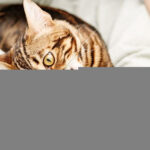Siberian cat size is a popular topic among cat enthusiasts, and at solcat.net, we’re here to provide a comprehensive guide on this fascinating breed. These majestic felines are known for their substantial size and captivating personalities, making them a favorite among cat lovers. To ensure your Siberian cat grows into a healthy and happy companion, understanding their growth patterns and nutritional needs is essential. Dive in to explore everything you need to know about Siberian cat dimensions, growth, and care.
1. Siberian Cat Size Compared to Regular Cats
Are you curious about the size differences between a Siberian cat and a regular domestic cat? Siberian cats generally exhibit distinct proportions compared to average felines. Typically, their backs feature a slight arch, positioning them higher than their shoulders, and their hind legs tend to be a bit longer than their front legs, contributing to a unique stance. These physical traits give them a distinctive appearance. Beyond these features, they’re also noticeably larger than standard house cats, which can surprise some prospective owners.
| Feature | Siberian Cat | Regular Cat |
|---|---|---|
| Weight | 5–7.5 kg (Male), 4–5 kg (Female) | Around 4.5 kg |
| Length | 43–63.5 cm | 40–46 cm |
| Height | 23–28 cm | 20–25 cm |
2. Siberian Cat Size Comparison with Other Breeds
How does the size of a Siberian cat stack up against other popular breeds? Here’s a detailed comparison to give you a clearer picture:
| Breed | Weight | Length (Nose to Tail) | Height |
|---|---|---|---|
| Siberian Cat | Male: 5–7.5 kg, Female: 4–5 kg | 43–63.5 cm | 23–28 cm |
| Maine Coon | Male: 6.9–11.4 kg, Female: 3.8–6.2 kg | 48–100 cm | 30.5–40.5 cm |
| Norwegian Forest Cat | Male: 4.5–9 kg, Female: 3.6–8 kg | 30.5–45.5 cm | 23–30.5 cm |
| Ragdoll | Male: 3.5–9 kg, Female: 3.5–7 kg | 43–53 cm | 23–28 cm |
| Bengal | Male: 4.5–6.8 kg, Female: 3.5–4.5 kg | 36–46 cm | 20–25 cm |
3. Maine Coon vs. Siberian Cat: What Are The Key Differences?
What are the main distinctions between Maine Coons and Siberian cats? At first glance, Maine Coons and Siberians might seem similar due to their fur length and lynx-like ear tips. Both breeds are well-boned, strong, and have medium-length legs. However, beyond these superficial similarities, key differences exist. Maine Coons are the largest domesticated felines, significantly bigger than Siberian cats. They also have broad chests and tails as long as their bodies, whereas Siberians are more barrel-shaped with shorter tails. Maine Coons have square-shaped heads with high, prominent cheekbones, while Siberians have rounded faces like regular cats. Both breeds are lovable and social, making them great companions.
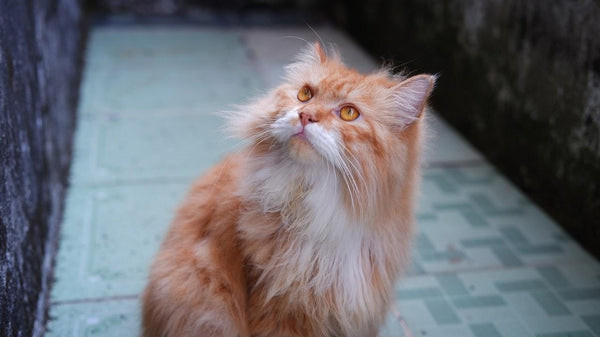 Maine Coon and Siberian cat comparison
Maine Coon and Siberian cat comparison
Maine Coons and Siberians might look alike at first glance, but notable differences set them apart.
4. Norwegian Forest Cat vs. Siberian Cat: What Are The Key Differences?
How do Norwegian Forest Cats compare to Siberian cats? Another breed similar to Siberians is the Norwegian Forest Cat. Both breeds are equally lovable and friendly, but notable size differences exist. Norwegian cats are generally larger, though particularly large Siberians can be similar to smaller Norwegian Forest Cats. Norwegians have shorter bodies with higher rumps and triangular head shapes, whereas Siberians have rounded heads. These subtle differences help distinguish the two breeds.
Norwegian Forest cats and Siberian cats share similarities, but size and head shape differentiate them.
5. Ragdoll vs. Siberian Cat: What Are The Key Differences?
What are the differences between Ragdolls and Siberian cats? Ragdolls can initially resemble Siberians, but closer inspection reveals distinct characteristics. Ragdolls can grow larger than Siberian cats and are recognizable by their color points and blue eyes. While some Siberian variants share these traits, the key difference lies in their personalities. Siberians are more active and playful, while Ragdolls tend to be calmer and more laid-back. Additionally, Ragdolls require more grooming than Siberians.
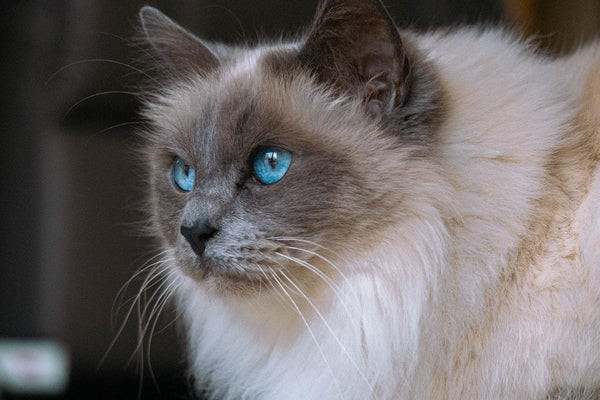 Ragdoll cat with blue eyes
Ragdoll cat with blue eyes
Ragdolls are known for their blue eyes and color points, but Siberians offer a more active personality.
6. Siberian Cat vs. Bengal: What Are The Key Differences?
What are the key differences between Siberians and Bengals? Siberians and Bengals share high energy levels, playfulness, and a love of water, but they differ significantly in body type. Bengals are lean and elongated, while Siberians are stockier and more robust. Despite these differences, their sizes are relatively similar. Bengals have distinctive spotted coats, whereas Siberians have long, dense fur, making them visually quite different.
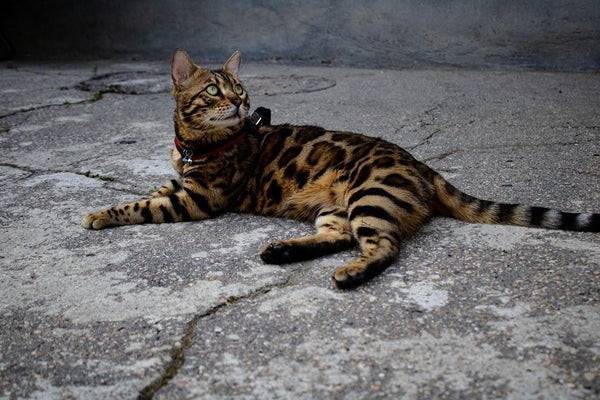 Bengal cat on a city street
Bengal cat on a city street
Bengals and Siberians both have high energy but differ in body type and coat.
7. What Factors Influence Your Siberian Cat’s Size?
What elements determine a Siberian cat’s size? Several factors play a role in determining how big your Siberian cat will grow:
- Genetics
- Sterilization status
- Diet
7.1 How Do Genetics Affect a Cat’s Size?
How do genetics influence a feline’s size? Genetics significantly influence your Siberian’s size, and this is something you can’t change. If your cat’s parents are large, your Siberian is likely to be big as well. While genetics dictate height and length, you can control their weight and growth rate through proper diet and care. Overfeeding your Siberian to make them bigger is not recommended, as it can lead to obesity and associated health issues.
7.2 How Does Desexing Impact Size?
What is the connection between desexing and size? Fixed Siberians tend to grow larger than intact felines. The earlier you spay or neuter your kitty, the larger they may grow. Sterilization can lead to weight control challenges, especially for indoor cats. Fortunately, Siberians mature slowly and often grow until they are four or five years old, staying active and kitten-like for longer, which helps in managing their weight.
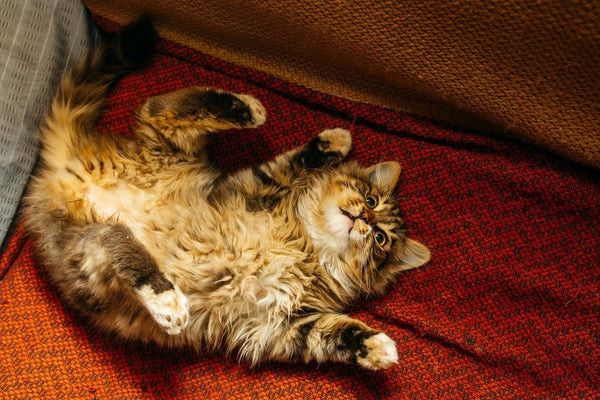 Siberian cat lying on a red textile
Siberian cat lying on a red textile
Fixed Siberian cats often grow larger, so monitoring their weight is essential.
7.3 How Does Diet Affect Growth?
How does diet influence your Siberian’s growth? While you can’t change your Siberian’s length and height, you can significantly affect their weight and physique through diet. The quality and quantity of food, along with feeding frequency, play crucial roles. High-quality food in appropriate portions helps maintain a healthy weight.
8. What Is The Ideal Diet For Your Siberian Cat?
What should your Siberian cat’s diet ideally consist of? A Siberian cat’s diet should mirror what they would eat in the wild. Cats are obligate carnivores, so their diet should primarily consist of animal protein. Whether you choose dry, wet, semi-moist, raw, or homemade food, it should be rich in meat and fish, which provide essential amino acids like taurine and arginine, as well as vitamins and minerals.
 Siberian cat eating meat
Siberian cat eating meat
Meat and fish should be the primary components of a Siberian cat’s diet.
Here is the ideal composition of cat food:
| Nutrient Group | Ideal Percentage |
|---|---|
| Animal Protein | More than 50% |
| Animal Fat | Up to 20% |
| Carbs | Less than 3% |
The best ingredients for healthy meals include cooked chicken, turkey, duck, salmon, sardines, prawns, mackerel, tuna, and liver. Pork, ham, and bacon can be given in moderation as treats. Always check the ingredients list and avoid foods containing vegetables, grains, or fruit.
8.1 What’s Wrong with Carbs?
Why should high-carb cat food be avoided? High-carb cat food can lead to:
- Obesity
- Diabetes
- Digestive issues
9. How Does Untamed Fit Into Your Siberian Cat’s Diet?
How can Untamed cat food benefit your Siberian cat’s diet? Untamed is an excellent choice to prevent your Siberian from becoming overweight and lethargic. Our meals are formulated to provide all the necessary nutrients for a long and happy life. All our recipes, whether cat jelly or gravy dishes, feature:
- Huge amounts of animal protein
- Vet-designed formulas
- Ethical production and logistics
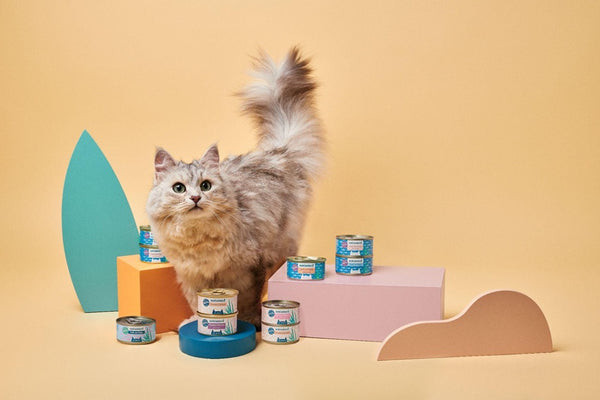 Untamed cat food
Untamed cat food
Untamed cat food is designed to fit perfectly into a Siberian cat’s diet plan.
9.1 Huge Amounts of Animal Protein
Why is high animal protein content important in cat food? Untamed meals are free from grains, sugar, vegetables, eggs, artificial colorants, flavor enhancers, and other harmful ingredients. We use top-tier whole meat and fish with a dash of animal fat. Even picky eaters will find our delicacies irresistible.
9.2 Vet-Designed Formulas
How do vet-designed formulas ensure optimal health for your cat? We collaborate with vets to ensure our meals have a perfect protein-to-fat ratio, suitable for cats of all ages and health conditions. Our formulas can prevent or help manage common health problems.
9.3 Ethical Production and Logistics
How does Untamed commit to ethical production and sustainability? We are dedicated to preserving our planet, which is why we:
- Cooperate exclusively with cruelty-free and sustainable suppliers
- Use 100% recyclable packaging
- Ensure carbon-neutral production and logistics
Want your Siberian to grow big and strong without becoming too chunky? Order Untamed and watch your kitty thrive!
10. Getting Untamed For Your Siberian Cat
How easy is it to get Untamed cat food for your Siberian cat? Ordering healthy cat food online has never been easier. To get a starter pack delivered to your doorstep:
- Share information about your Siberian cat on our website, solcat.net.
- Create a meal plan tailored to your kitty’s needs and preferences.
- Complete your order.
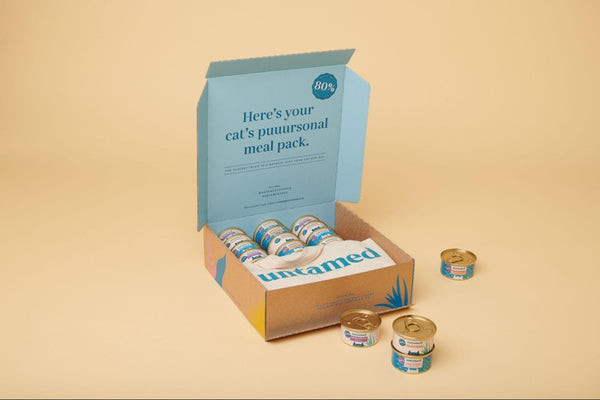 Delivery of Untamed cat food
Delivery of Untamed cat food
Untamed cat food is delivered right to your doorstep.
The best part is that you never have to worry about replenishing your cat food cabinet. We can send a new batch of your kitty’s favorites at the same time every month.
Cat parents who have switched to Untamed have provided fantastic feedback. They describe the following effects of our healthy and delicious food:
| Timeline | Results |
|---|---|
| After a week | Excellent mood, easy digestion |
| Within two months | More muscular physique, healthy eating habits |
| Within four months | Shinier and softer fur, less shedding and fewer hairballs |
| Life-long | Normal energy levels, easy weight management, better overall health |
11. Are Siberian Cats Good Pets?
What makes Siberian cats good pets? When choosing a feline companion, consider more than just size. If you’re considering a Siberian cat, learn about their:
- Personality
- Health
- Grooming needs
- Hypoallergenic status
11.1 Are Siberian Cats Friendly?
How friendly are Siberian cats? Siberian cats are fantastic companions. They are friendly, fearless, playful, and docile. They enjoy meeting strangers, get along well with kids and other pets, and thrive on attention. They adapt well to environmental changes, provided they aren’t too frequent or sudden. Siberians mature slowly, remaining kitten-like for about five years.
11.2 Are Siberian Cats Healthy?
How healthy are Siberian cats in general? Siberians are generally healthy, with an average lifespan between 10 and 18 years. Proper care and nutrition can extend their life expectancy. However, they are prone to certain hereditary health issues:
- Hypertrophic cardiomyopathy (HCM): Thickening of the heart muscle, affecting blood pumping efficiency. Obesity is a major risk factor.
- Polycystic kidney disease (PKD): Genetic mutation causing cysts on the kidneys, leading to renal failure.
- Feline lower urinary tract disease (FLUTD): Includes UTIs, bladder stones, and cystitis.
- Gum disease: Common due to poor dental hygiene and inadequate diet.
Regular vet check-ups can help detect and manage these conditions early. The American Animal Hospital Association (AAHA) recommends annual check-ups to maintain your cat’s health.
11.3 Are Siberians Difficult to Groom?
How much grooming do Siberian cats require? Despite their long fur, Siberian cats are easy to groom. Regular care includes:
- Regular brushing: Once a week is enough to prevent matting.
- Occasional bathing: Every two months or when dirty.
- Frequent teeth cleaning: Daily brushing to prevent plaque buildup.
- Periodic nail clipping: Trim the tips if they get too sharp.
11.4 Are Siberian Cats Hypoallergenic?
Are Siberian cats truly hypoallergenic? Unfortunately, Siberian cats are not entirely hypoallergenic. All cats produce Fel d 1 protein, which causes allergic reactions. However, Siberians produce less Fel d 1, making them suitable for some allergy sufferers. If you have allergies, consider:
- Brushing them more often, outdoors.
- Dusting and vacuuming frequently.
- Using a HEPA-equipped vacuum cleaner.
- Replacing upholstered furniture.
Consult a specialist before adopting a cat if you have severe allergies.
Siberian cats are truly majestic creatures that bring joy and companionship to many homes. Understanding their size, growth patterns, and care requirements ensures they live healthy and happy lives. Whether you’re a current owner or considering adopting one, solcat.net offers a wealth of information to guide you on your journey.
Ready to explore more about Siberian cats and other fascinating feline breeds? Visit solcat.net today for reliable, up-to-date information and connect with our community of cat lovers!
Address: 950 Alaskan Way, Seattle, WA 98104, United States
Phone: +1 (206) 386-4000
Website: solcat.net
FAQ About Siberian Cat Size
1. How big do Siberian cats typically get?
Siberian cats typically weigh between 8 to 15 pounds (3.6 to 6.8 kg). Males are generally larger, reaching up to 17 pounds (7.7 kg), while females usually stay within the 8 to 12 pound (3.6 to 5.4 kg) range. According to the Cornell Feline Health Center, genetics and diet significantly impact a cat’s size and weight.
2. Are Siberian cats considered a large breed?
Yes, Siberian cats are considered a medium-to-large breed. They are known for their sturdy build and substantial size compared to average domestic cats.
3. How fast do Siberian cats grow?
Siberian cats have a slow growth rate and typically reach their full size around 5 years of age. This extended growth period allows them to develop their muscular physique and dense coat fully.
4. What is the average length of a Siberian cat?
The average length of a Siberian cat, from the tip of their nose to the end of their tail, ranges from 17 to 25 inches (43 to 63.5 cm). This makes them noticeably longer than many other domestic cat breeds.
5. Do male and female Siberian cats differ in size?
Yes, male Siberian cats are generally larger and heavier than females. Males can weigh up to 17 pounds (7.7 kg), while females typically weigh between 8 and 12 pounds (3.6 to 5.4 kg).
6. What should I feed my Siberian cat to ensure healthy growth?
To ensure healthy growth, feed your Siberian cat a high-quality diet rich in animal protein. Look for cat foods that list meat, fish, or poultry as the primary ingredient and avoid foods with excessive fillers like grains and corn. Untamed cat food, available at solcat.net, is an excellent option due to its high protein content and vet-designed formulas.
7. How does spaying or neutering affect the size of Siberian cats?
Spaying or neutering can affect a Siberian cat’s size. Fixed cats tend to have slower metabolisms, which can lead to weight gain if their diet isn’t carefully managed. However, sterilization can also allow them to grow larger as it removes hormonal influences that regulate growth.
8. Are Siberian cats prone to obesity?
Siberian cats can be prone to obesity if overfed or not given enough exercise. Monitor their food intake and ensure they have plenty of opportunities to play and stay active.
9. How do I know if my Siberian cat is overweight?
You can tell if your Siberian cat is overweight by feeling their ribs. If you can’t easily feel their ribs with a light touch, they are likely overweight. Also, look for a lack of a defined waistline and a rounded belly.
10. What are the health concerns related to the size of Siberian cats?
While Siberian cats are generally healthy, their size can predispose them to certain health issues, such as hypertrophic cardiomyopathy (HCM) and joint problems. Maintaining a healthy weight and providing regular exercise can help mitigate these risks. For more information on Siberian cat health issues, visit solcat.net.

